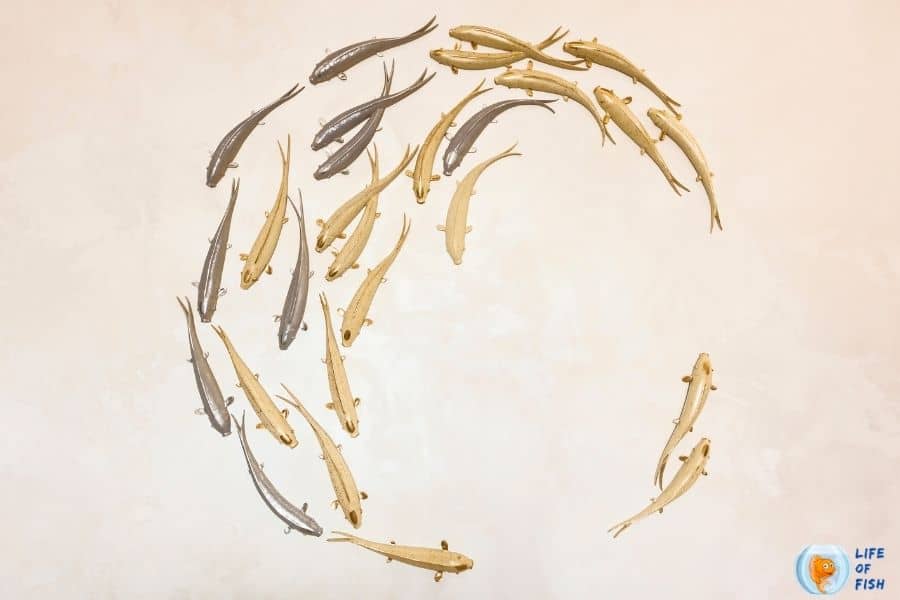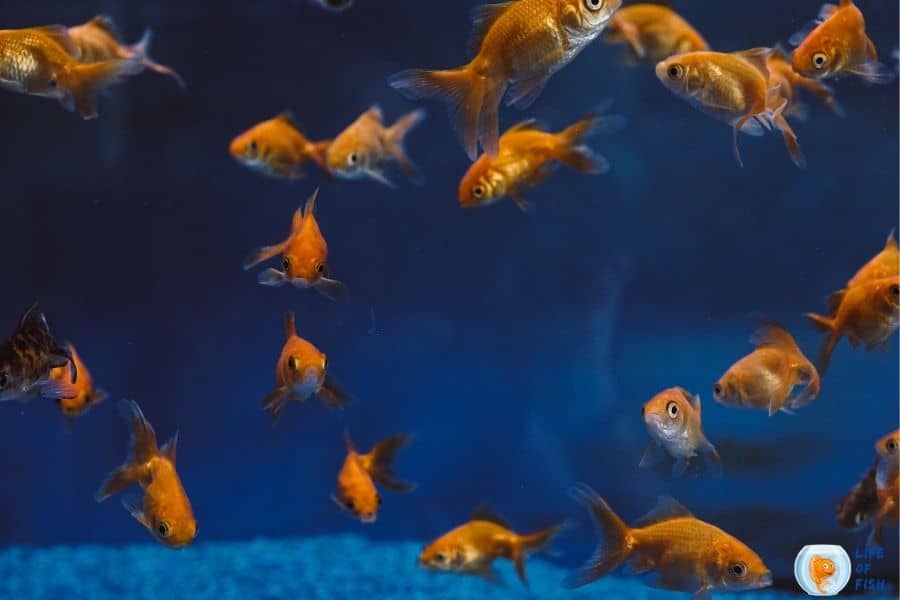Is your fish swimming in circles? Healthy fish do not swim in circles, at least for an extended period of time. If your fish is swimming in circles, it is something you should be concerned about and look into further.
There are several potential causes for fish swimming in circles, some of which are more serious than others.
This article will explore the potential causes for fish swimming in circles and what you can do to help your fish.

Why is my fish swimming in circles?
Jump To
If your fish is swimming in circles occasionally, there’s probably nothing to worry about, as healthy fish sometimes swim in circles due to boredom or as a way of exercising.
However, if your fish is swimming in circles constantly, it could be a sign of a health problem.
Potential causes for fish swimming in circles include:
- Ammonia Poisoning
- Stress
- Swim Bladder Disorder
- Whirling Disease
Let’s talk about each cause and what you can do about it.
Ammonia Poisoning
One potential cause for fish swimming in circles is ammonia poisoning. Ammonia is a poisonous gas that is produced when fish waste breaks down.
When levels of ammonia in the water get too high, it can poison fish and cause a variety of health problems, including swim bladder disorder.
Unfortunately, Ammonia strikes can happen suddenly or overtime. Sudden ammonia poisoning is more likely to occur when a fish tank is first set up, and the levels of ammonia in the water are not yet stabilized.
Ammonia poisoning can also occur over time if the tank is not adequately cleaned and levels of ammonia build up in the water.
Other possible causes of ammonia poisoning include;
- overfeeding
- under-filtering
- adding too many fish to the tank at once
While you can control the damage of sudden Ammonia strikes, Ammonia poisoning over some time can seriously impact your fish’s internal organs, including the brain and the central nervous system. Your fish might begin to hemorrhage both internally and externally, and it may die as a result.
Below is a list of common symptoms of ammonia poisoning in fish:
- Lethargy
- Loss of appetite
- Gasping at the water surface
- Clamped fins
- Listless swimming
- Red or purple gills
- Bloody patches on the body
- Staying at the bottom of the tank
Here’s what you can do to prevent and treat Ammonia poisoning:
It’s essential to keep your fish tank clean to prevent Ammonia poisoning. You should do a partial water change (25-50%) every week and clean the filter monthly.
If you suspect that your fish is suffering from ammonia poisoning, the first thing you should do is check ammonia levels in your tank. You can do this with an ammonia test kit, which you can purchase at your local pet store.
If the ammonia levels in your tank are high, you should do a water change immediately. At the same time, you should stop feeding your fish and remove any uneaten food from the tank so that the tank doesn’t get any dirtier.
You can also treat ammonia poisoning with a water conditioner that neutralizes ammonia. Ammonia Neutralizer by Aqueon is one product that you can use.
Following these steps does not guarantee that your fish will survive, but it will give them a better chance.
Usually, ammonia poisoning is fatal, so it’s essential to take action quickly if you think your fish might be suffering from it.

Stress
Another potential cause for fish swimming in circles is stress. Fish can get stressed for a variety of reasons, including;
- Poor water quality
- Crowding
- Lack of hiding places
- Intimidation by other fish
- Excess noise or light
- Changes in the tank’s environment
When fish are stressed, they release a hormone called cortisol. Cortisol can lead to countless health problems, including swim bladder disorder and infectious diseases like fin rot and ick.
Fish that are stressed are more prone to disease and may have a shortened lifespan.
Here are some common symptoms of stress in fish:
- Loss of appetite
- Gasping at the surface of the water
- Floating at the surface of the water
- Hiding
- Lethargy
- Clamped fins
Fortunately, stress can be prevented and treated if you remove the stressors from the tank. However, observing your fish is necessary to determine the stressor.
Here’s how you can prevent and treat stress in fish
Maintaining good water quality in your tank is essential to avoid stress. You should do a partial water change (25-50%) every week and clean the filter monthly.
You should also ensure that your fish have enough hiding places in the tank. Live aquatic plants are a great way to provide hiding places, and they also help oxygenate the water.
Further, remove any bullying fish from the tank so that your fish can have a relaxed environment. If your tank is overcrowded, you should do something about it as well.
If your fish are already stressed, you can try to reduce their stress levels by adding a water conditioner to the tank.
Stress Coat by API is one product that you can use. It has a scientifically proven formula to reduce fish stress and heal damaged fish.
After using a water conditioner, find the stressor in the tank and remove it. Once you’ve done that, the fish should start to recover.
If your fish is already infected with a disease because of stress, you should treat the disease according to its instructions.
Swim Bladder Disorder
Swim bladder disorder, in fact, is not a single disease but a group of diseases that affect a fish’s swim bladder. The swim bladder is an organ that allows fish to float or sink in the water.
The swim bladder organ does not function correctly when a swim bladder disease strikes. Consequently, the fish will start to experience buoyancy difficulties and will be unable to regulate its floating or sinking ability.
Swim bladder condition is usually caused by a bacterial infection, although it can also be caused by parasites, physical damage, or genetic defects.
Another common cause of swim bladder disorder is constipation. This is because a constipated fish will have difficulty passing gas, which can build up in the swim bladder and cause problems.
Here are some common symptoms of swim bladder disorder:
- Floating at the surface of the water
- Sinking to the bottom of the tank
- Buoyancy issues
- Swimming in circles or an erratic pattern
- Loss of appetite
The good news is that you can treat swim bladder disorder with antibiotics. However, you will need to first take your fish to the vet for a proper diagnosis.
Here’s what you can do to prevent swim bladder disorder:
The best way to prevent swim bladder disorder is to maintain good water quality in your tank. You should do a partial water change (25-50%) every week and clean the filter monthly.
You should also feed your fish a high-quality diet and avoid overfeeding them. A healthy diet will help to keep their digestive system working properly and prevent constipation.
Finally, make sure that your fish have enough space to swim in the tank. If the tank is too small, the fish will have difficulty swimming, leading to Swim Bladder problems.
Here’s how you can treat swim bladder disorder:
If your fish is suffering from swim bladder disease, the first thing you need to do is figure out what is causing the problem.
If the cause is constipation, you can try to treat it with a high-quality diet. But before doing anything, you should fast your fish for about three days.
If you fast your fish, swim bladder issues caused by constipation usually go away on their own after a few days.
However, if constipation persists, you can try to treat it with laxative food such as skinned peas. Some fish species can benefit from the usage of daphnia or brine shrimp as a laxative.
If the cause of swim bladder disorder is a bacterial infection, you will need to take your fish to the vet for treatment with antibiotics.
You can also try treating your fish with aquarium salt. This will help kill the bacteria and reduce the swelling in the fish’s swim bladder.
If your fish has swim bladder disorder caused by physical damage, there is not much you can do. The best thing to do is provide your fish with a stress-free environment and hope that it will recover independently.
If you can spot parasites on the fish’s body, that might cause swim bladder disorder. You can use a commercial parasite treatment or make your own with garlic and water to treat this.
If the cause of swim bladder disorder is unknown, you can try treating your fish with a broad-spectrum antibiotic.
You can also try accumulating aquarium salt in the tank. This will aid in the elimination of any bacteria that may be causing the issue.

Whirling Disease
Whirling disease is another cause of fish swimming in circles. The Myxozoan parasite Myxobolus cerebralis causes whirling disease in freshwater fish.
Although the illness is prevalent among wild Salmonidae species, it affects all aquarium fish, including discus, corydoras, goldfish, and tetras.
What makes this parasite more dangerous is that it can remain alive in two main hosts; freshwater Oligochaete worms such as tubifex and the fish themselves.
When the parasite infects the fish, it enters their bloodstream and travels to the inner ear and the brain.
The parasite multiplies inside the fish’s brain, causing damage and inflammation. This damage can lead to a loss of balance and coordination, which is why the fish swims in circles.
The parasite can also infect the fish’s skeletal muscle, causing deformities and weakness. In severe cases, the fish may be paralyzed and die.
There is no known remedy for whirling disease, so the best thing you can do is prevent it from infecting the fish in the first place.
One way to do this is to quarantine new fish before adding them to your tank. You should also avoid buying live food, as this can be a carrier of the parasite.
Some common symptoms of whirling disease include:
- fish swimming in circles
- loss of balance and coordination
- deformities in the skeletal muscle
- floating head down
- developing a bent spine
- emaciation
- paralysis
- death
If you notice the above signs in your fish, you should take them to the vet as soon as possible. Whirling disease is fatal, so early diagnosis and treatment are essential.
What you can do if your fish is diagnosed with whirling disease
Unfortunately, it is impossible to cure your sick fish, and you will have only three options.
Try to treat the fish
When a fish is infected with the whirling disease, the damage caused by the parasite is irreversible. However, you can try to treat the symptoms and make your fish more comfortable.
Only one medication is proven to work in some fish, and that is kanamycin. However, this drug is not available in all countries.
You will have to treat your fish for an extended period of time to see some progress. Usually, it will be three months or so.
To treat your fish, first, you have to remove the sick fish from the aquarium to stop spreading the disease to other fish. Place the affected fish in a hospital tank with the same water parameters as the main aquarium.
Start treating your fish with kanamycin following the dosage on the label. It will be better if you combine the treatment with antibacterial medications such as Furan 2 and Metronidazole to prevent bacterial infections. After three weeks, do a 25% water change and add fresh, treated water to the hospital tank.
Whirling disease is a stubborn disease, and only a small percentage of fish survive even after treatment. Your fish survival is even lower if the parasite has damaged its brain or skeletal muscle.
Euthanize your fish
As we said before, whirling disease is a fatal disease, and the chances of your fish surviving are very low. If you don’t want to see your fish suffer, the best thing you can do is to euthanize them.
A qualified vet should do euthanasia, and you can use several methods. The most popular technique is to inject a euthanasia solution into the fish. This solution quickly knocks the fish out and then kills them.
Another way is to use clove oil. This procedure is less traumatic for the fish, but it is a little slower.
To euthanize your fish using clove oil, first, you need to add one teaspoon of clove oil for every gallon (3.8 L) of aquarium water.
Then, you need to catch your fish and place them in a container with the clove oil solution. The fish will perish in around 5 to 6 minutes.
After your fish has died, you need to dispose of their bodies properly. The best approach to do this is to bury them in your garden.
Do nothing and let the fish die itself
If you can’t euthanize your fish or don’t want to, you can just do nothing and let the disease take its course. However, we don’t recommend this, as it is very cruel to see a fish suffer and die a slow and painful death.
If you still choose to do this, you should remove the sick fish from the aquarium and place them in a hospital tank.
Otherwise, millions of Myxozoan parasites will be released upon the fish’s death. These parasites can infect all fish in the aquarium within days.
As we said before, whirling disease is fatal, and there is no cure. In rare cases, some fish recover from this disease. However, they will carry the parasite for the rest of their lives and can infect other fish.
To prevent your fish from getting this disease, you need to buy them from a reputable breeder or pet store. Before adding additional fish to your aquarium, you should quarantine them.

Why do schools of fish swim in circles?
There are a few reasons why schools of fish swim in circles. One reason is that it helps them stay together as a group.
When fish are swimming in a school, they can communicate with each other using chemicals. This helps them stay together and avoid predators.
Another reason why fish swim in circles is that it helps them stay warm. When fish swim close together, they can share their body heat. This is important in cold water, as it helps the fish stay warm and avoid hypothermia.
Schools of fish often swim in circles when they are feeding. This helps them to corral their food and eat as much as possible. It also allows them to keep an eye out for predators.
Further, they display this behavior when they spawn. When fish are ready to lay their eggs, they often swim in circles. This helps to keep the eggs together and makes it easier for the male fish to fertilize them.
Why is my fish swimming in circles upside down?
There are a few reasons why your fish might be swimming in circles upside down.
One possibility is that they are suffering from swim bladder disease. This condition affects the swim bladder, the air sac that helps fish float.
If the swim bladder is damaged, it can cause the fish to float upside down. This is because the fish is no longer able to control its buoyancy. A bacterial infection usually causes swim bladder disease.
Another probability is that your fish has a tumor. This can cause the fish to swim abnormally and might even make them swim upside down. Tumors are usually benign, but they can be cancerous.
A third possibility is that your fish has a neurological disorder. This can cause them to swim in circles and even swim upside down. A virus or a parasite usually causes neurological disorders.
If your fish is swimming in circles upside down, you should take them to the vet as soon as possible.
Conclusion
Swimming in circles is a natural behavior for fish, and there is nothing to worry about if you see your fish doing it.
However, it could be a wicked sign if you notice that your fish are swimming in circles more than usual. It could be a sign of stress, illness, or injury. If you’re worried about your fish, the best thing to do is take them to a vet.
Read Next : Yellow Stripe Clingfish Care | A Needle Like Fish |
